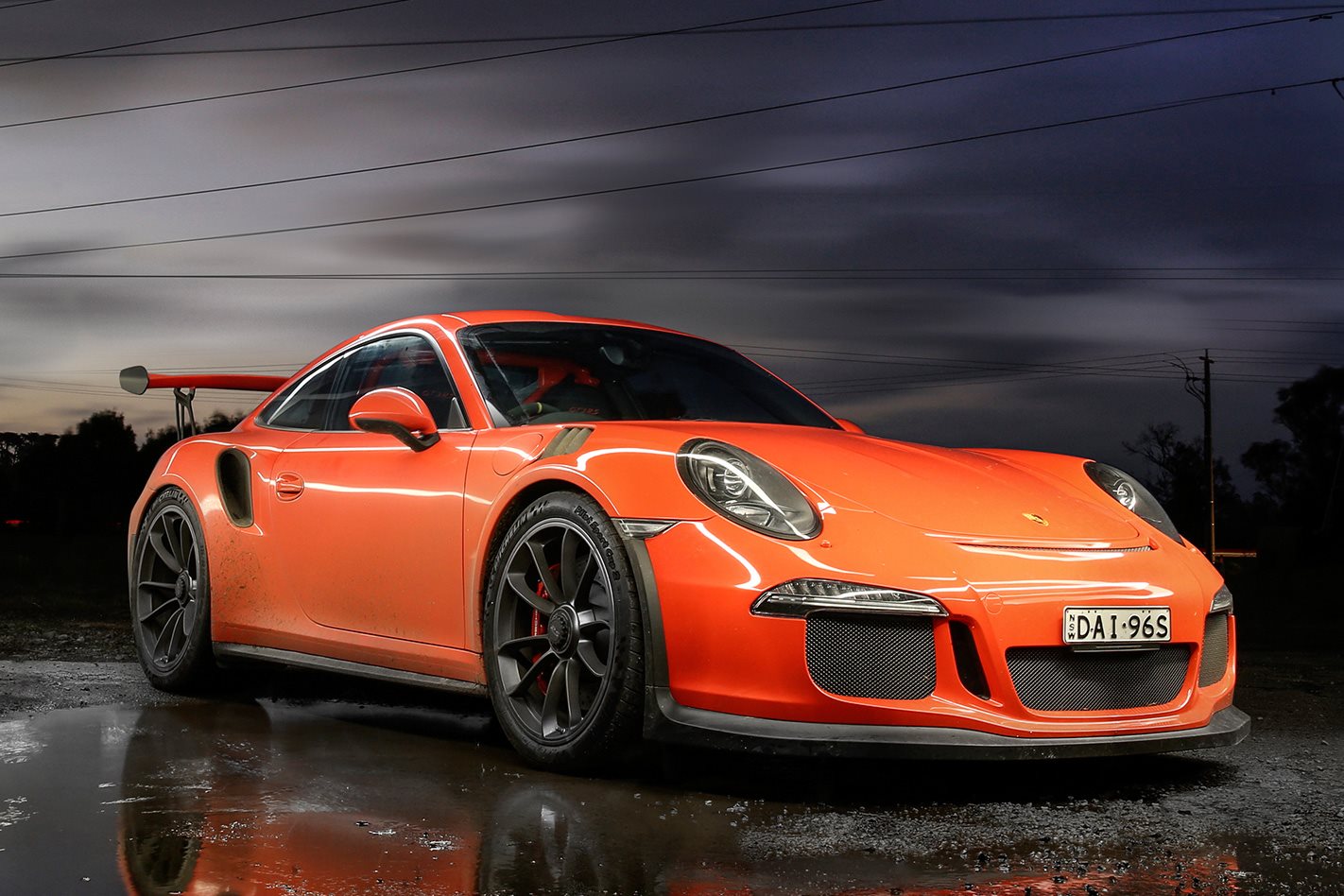A dry-sump flat-six that can rev to 8800rpm, a lofty rear wing that contributes 224kg of downforce at 300km/h and semi-slick tyres more or less pinched off the 918 Spyder hypercar. And I’m just glad it has a demister.
Contrary to popular ridicule, and the experience of those living in Melbourne, it rains nearly twice as much in Sydney each year. They wouldn’t make very good fortune tellers but the Bureau of Meteorology has some excellent records which show that, in the last 160-odd years, those closest to the tropics have received 1164 median millimetres every year, the southerners 644mm.
But the real clincher is Sydney’s 103.9 average annual “clear” days to Melbourne’s comparatively abysmal 48.6, and while we have cherry-picked sexy-looking statistics here, rainfall aside the general data does attest to Melbourne being a colder and cloudier place.
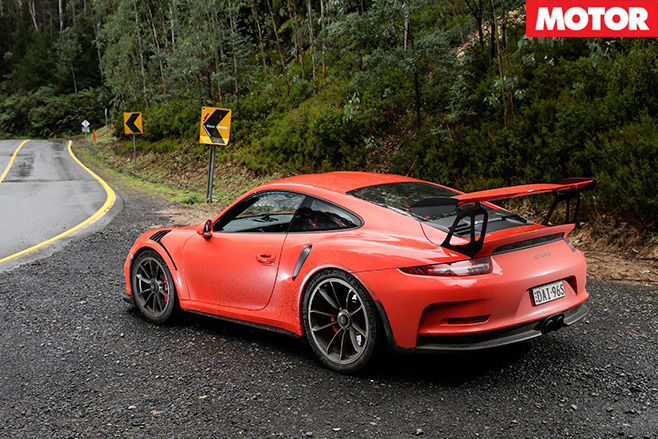
Though the conditions for our test were mostly cloudy there was never any risk of us being missed. Headlights on or off, the 911 GT3 RS magnetically attracts eyeballs everywhere it goes in its ($5990 extra) Lava Orange paintjob. And in the city it can’t help but look permanently lost, like one could pull up next to you at any moment, wind its window down, the befuddled driver enquiring which way to the nearest racetrack.
We weren’t sure what to expect of this car. Last year we were blown away by the 991 911 GT3 such that, in our cross-country 11-car shootout in the Victorian alps, it pipped Mercedes-AMG’s stonking new GT S hero coupe to become our reigning Performance Car of the Year. When so many cars have a great engine, or a great chassis, or great steering, but rarely all of them at once, it seemed the 911 GT3 did – its howling flat-six nat-atmo engine and sweet-handling chassis wooing all present. (Except ex-editor Tim Robson, who voted the AMG GT S ahead of it, but no-one’s infallible.)
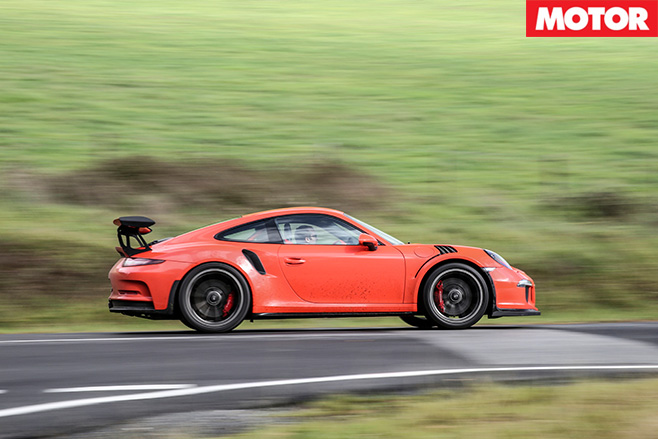
So you can imagine our reaction when we first read of the RS with the same specification tyres as the 918 Spyder hypercar (dimensionally at least – though both Michelin Pilot Sport Cup 2 they’re a slightly different compound), a car 214kg heavier with its hybrid gear and having to deal with 75 per cent more power. Putting them under a 911 seemed overkill, but nothing bespeaks the balls-out philosophy of this car more.
Of course, MOTOR has history with not only the GT3 but the RS. The previous generation car was something truly special – easily forgiven for its gaudy stickers thanks to three pedals, 3.8 litres of flat-six pumping 12.0:1 compression at 8400rpm, good for 331kW and 430Nm and making the rudest noise in the process. A car that weighed 1370kg and yet was more than the sum of its parts. It was our 2010 Performance Car of the Year.

Gaping vents on the front guards pump enormous quantities of air, contributing to the car’s special aerodynamic tricks (121kg at the front at 300km/h for a total of 345kg downforce). And an equally extreme price, starting from $387,300, nearly 100 large more than the normal GT3.
Delve deeper and you see where your money is going. The engine is stroked from 3.8 to 4.0 litres, power up from 350kW to 368kW and torque, 440Nm to 460. Any MOTOR reader worth their salt should have just twigged that some of those specifications sound very familiar indeed – it can’t be just coincidence the GT3 RS has a 4.0-litre nat-atmo flat-six making 368kW and 460Nm, exactly the same as the greatest 997 911 there ever was, the GT3 RS 4.0 whose Mezger race engine was famously pinched from the GT3 R and RSR race cars and adapted for road use. Both cars are made by the same person after all, Porsche’s motorsport boss Andreas Preuninger.
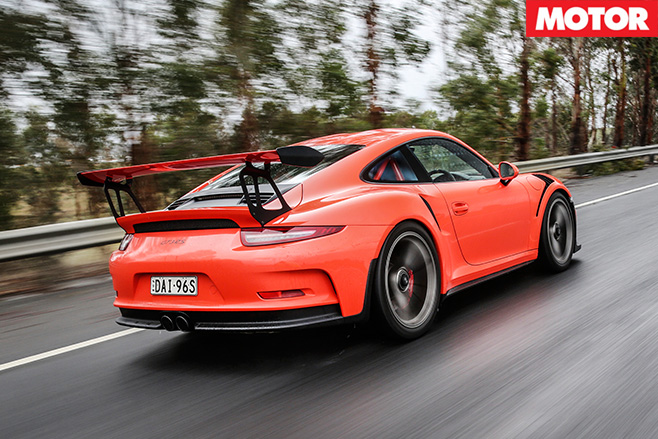
With a ’Ring lap time of 7:20sec (23 seconds slower than a 918, but seven seconds quicker than the RS 4.0 and eight seconds quicker than a Carrera GT) Porsche claims the RS is also five seconds quicker than the base GT3. Which works out to be $18K per second – for when time truly is money.
The RS proves, too, you don’t need two atmospheres to go fast down the strip, Porsche claiming 3.1sec to 100km/h and a 11.2sec quarter mile, and worth remembering Porsche is the kind of company to use, for their claimed performance figures, the slowest of perhaps 50 runs at the test track, rather than the fastest.
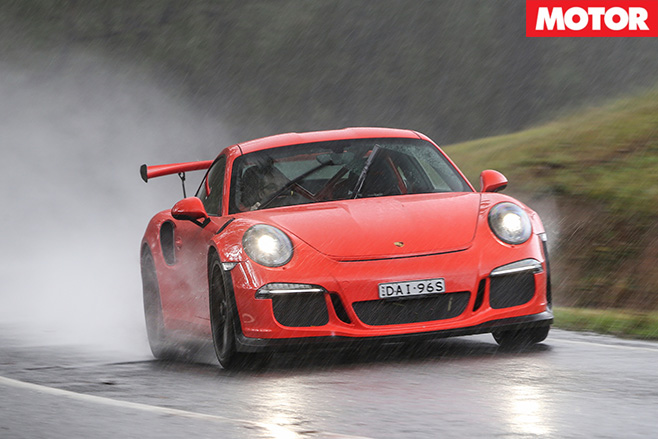
Instead, for all our efforts to build heat into those huge rear tyres, wheelspin was always in abundance. And while we’re happy to pass the buck to Porsche for supplying a car with very tired rear bags, 0-100km/h in 3.7sec on dead rubber and an 11.6sec quarter at 201km/h is still plainly ludicrously fast for a car built mostly for corners. We’ve heard, too, of this exact car dipping under the threes – on fresher rubber.
Even at the best of times those same Pilot Sport Cup 2s are not made for the wet, let alone after they’ve been through god-knows how many ham-footed journalists who aren’t paying Michelin’s invoices. And so our very damp time with the 911 GT3 RS was at the very least, exciting.
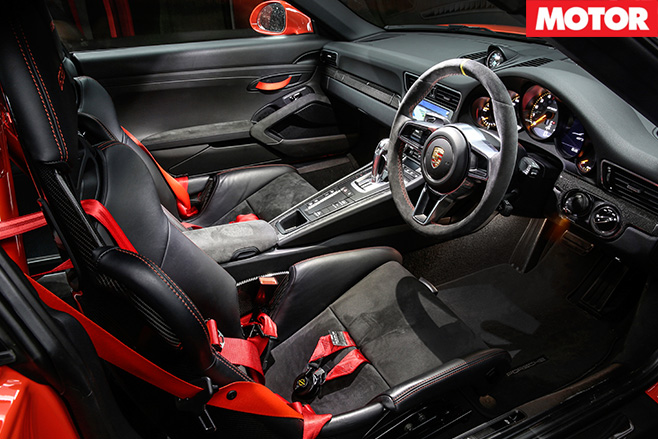
The GT3 RS spurns reversing cameras or even sensors, you’d think to save weight (there is a sticker for the front badge after all) although curiously it still has headlight washers (to help the weight distribution?). Rear visibility is passable despite looking through a body-coloured four-point cage and half-a-metre-high rear wing.
The big tacho’s last yellow increment is 8400, 600 less than GT3. And in the centre stack of buttons the one marked “Pit Speed” – unique to RS – is in my books the chintziest thing you’ll find in any Porsche and that’s saying something, as Porsche doesn’t do glitter. (The button is like a separate cruise control you can set up to 88km/h.) But otherwise you could be in a GT3, bar the RS-specific coloured canvas tabs for interior door grabs.
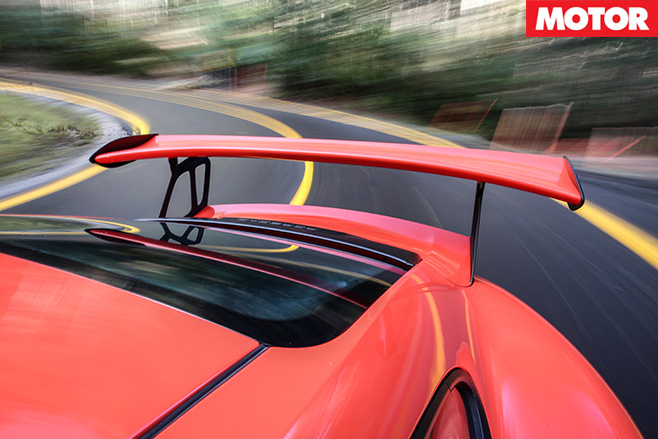
The RS is remarkably civil around town. It rides well most of the time, surprising considering the 35-profile tyres (30 rear) and the fact you can barely fit a finger between the rear wheel and the guard. Some people could daily drive this car. Put earplugs and an inflatable doughnut cushion in the glovebox and you’d be eternally prepared for a short-notice interstate track day.
When it’s raining, as we found, you don’t drive the 911 GT3 RS quite so much as you transport it. Up and down our chosen road for photography, it was very, very dicey. We will save you the bore of driving such a car in the wet but suffice to say, by the end of it, we had next to no clue how much lateral grip the tyres had and a millimetre-precise knowledge of available traction.

But career through enough corners in the dry to build some heat and those same tyres could be called bipolar. Fortunately for MOTOR, the heavens cleared just long enough, and over just enough corners, that we could unleash the RS in all its fury. And we were both lost for words and tempted to be never seen again.
In first gear you are thrust into your thinly-padded seat in a way that makes watching the tacho for second gear difficult and the limiter easily snagged. Dry traction is enormously strong and of course the RS will easily accelerate to speeds not fit for publishing. Its acceleration, for a nat-atmo 4.0-litre six-cylinder engine, is nothing short of spectacular.
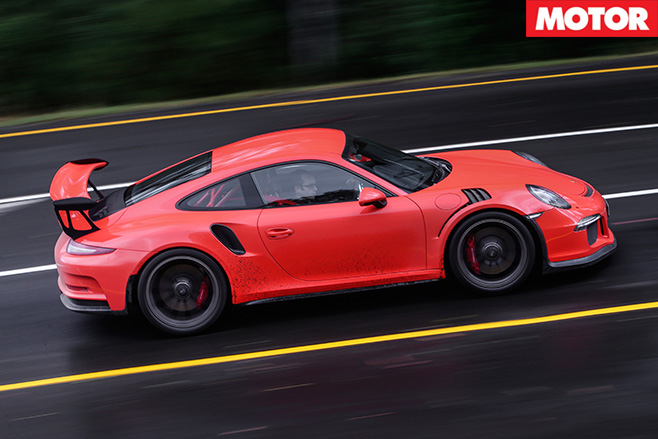
It sounds serious, too, like a Carrera Cup car missing all its sponsor stickers. It’s symphonic, screaming at 8400rpm, a high-tempo, rich and distinct, yet serious-sounding flat-six bark. A car for tunnels, for sure.
Perhaps it won’t surprise to say this is one car with the chassis to match its engine. The suspension performance is incredible, the car so composed and calm at speeds well beyond 110km/h. Over bumps at speeds that other cars would be breaking a sweat, the RS feels like it’s shrugging its shoulders. It’s fertiliser for your confidence. Stability at seemingly any speed is one of its core handling themes and though we punted through precious few fast corners to make a definitive call, the aero would absolutely play a leading part.
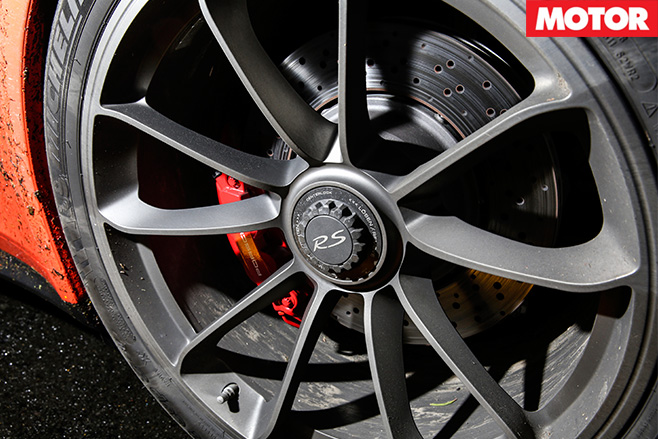
Our time in the dry with the GT3 RS, whether 100 kilometres or a thousand, was always going to feel too brief, but a theme emerged quickly: one of enormous performance that would take time to properly tap. You go into a corner and think, yep, I estimate this is going to be eight tenths and in fact it’s six.
There is so much performance left in the car that you really have to unpeel it slowly over time. The amount of speed you can carry into corners in particular, helped by the all-wheel steering and those 918-sized wheels and tyres, is plain cheeky.
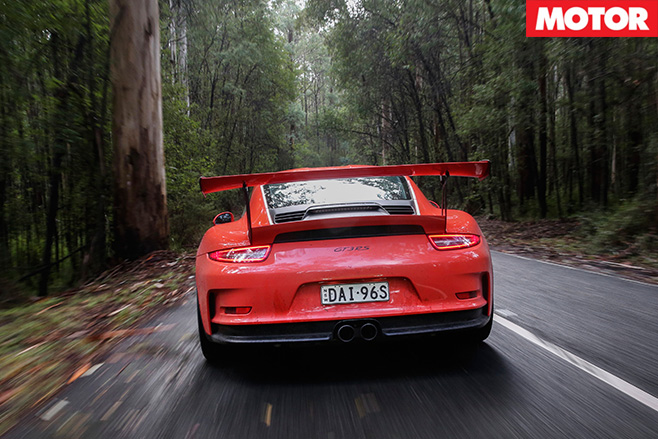
Without driving it again in the dry, it’s truly a hard one for us to place this car in the annals of 911 greatness. Personally as a motoring journalist I am often asked what is the best car I’ve ever driven and my standard answer has been the Ferrari 458 Speciale.
But it’s no longer an unthinking response; the RS had the potential to pip it, I felt, if only we got to drive it more. And given we were the last press booking in Australia, with all cars sold, we mightn’t ever know. Although it’s particularly lucky for the cars on our 2017 Performance Car of the Year shortlist. This car is a winner right here.
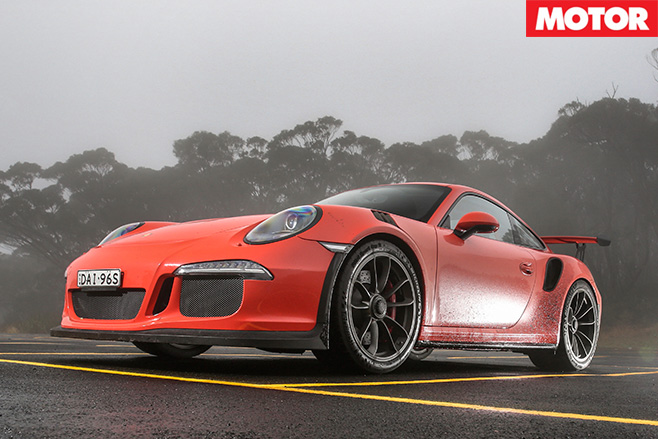
And not least because of the windscreen wipers. They’re pretty excellent, too.
5 OUT OF 5 STARS
LIKE: Everything – power, brakes, electronics, chassis, noise. It’s almost perfect DISLIKE: Best enjoyed in the dry, and over shorter distances
SPECS Body: 2-door, 2-seat coupe Drive: rear-wheel Engines: 3996cc flat-6, DOHC, 24v Bore/stroke: 102.0 x 81.5mm Compression: 12.9:1 Power: 368kW @ 8250rpm Torque: 460Nm @ 6250rpm Power/weight: 259kW/tonne Transmission: 7-speed PDK Weight: 1420kg Front suspension: struts, coil springs, anti-roll bar Rear suspension: multi-links, anti-roll bar L/W/H: 4545/1880/1291mm Wheelbase: 2457mm Tracks: 1587/1557mm (f/r) Steering: electrically-assisted rack-and-pinion Front brakes: 380mm ventilated/drilled discs, 6-piston calipers Rear brakes: 380mm ventilated/drilled discs, 4-piston calipers Wheels: 20 x 9.5-inch (f); 21 x 12.5-inch (r) Tyres: 265/35 ZR20 (f); 325/30 ZR21 (r) Michelin Pilot Sport Cup 2 Price as tested: $412,970

